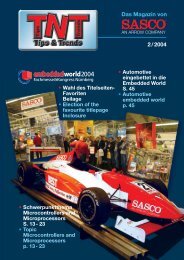steht die TNT als PDF zum Download - ISI-Design
steht die TNT als PDF zum Download - ISI-Design
steht die TNT als PDF zum Download - ISI-Design
Sie wollen auch ein ePaper? Erhöhen Sie die Reichweite Ihrer Titel.
YUMPU macht aus Druck-PDFs automatisch weboptimierte ePaper, die Google liebt.
Analog and Linear<br />
Neue Niederspannungs-Rail-to-<br />
Rail-Verstärker von Analog<br />
Devices erhältlich<br />
Bei den Typen AD8091 (single)<br />
und AD8092 (dual) handelt<br />
es sich um spannungsrückgekoppelte<br />
Verstärker,<br />
<strong>die</strong> für den Betrieb an Versorgungsspannungen<br />
von<br />
+3 V, +5 V oder ±5 V<br />
entwickelt wurden.<br />
Die OpAmps kommen mit<br />
nur einer Versorgungsspannung<br />
aus, wobei der Eingangsspannungsbereich<br />
bis auf 200 mV unter <strong>die</strong><br />
negative sowie bis 1 V an<br />
<strong>die</strong> positive Versorgungsspannung<br />
heran reicht. Der<br />
Ruhestrom beträgt max.<br />
5 mA.<br />
Technische Daten:<br />
• Bandbreite: 110 MHz<br />
•Slewrate: 145 V/µs<br />
• Einschwingzeit: 50 ns<br />
auf 0,1% bei +5 V<br />
Die Verstärker können bei<br />
Verstärkung G=1 eine kapazitive<br />
Last von 50 pF mit<br />
45 mA bei 0,5 V unter Versorgungsspannung<br />
treiben.<br />
Der Spannungshub am<br />
Ausgang reicht bis auf 25 mV<br />
an <strong>die</strong> Versorgungsspannung<br />
heran.<br />
Bis 20 MHz weisen <strong>die</strong> Bauteile<br />
eine Verstärkungs-<br />
Konstanz von 0,1 dB bei<br />
150 Ohm Lastwiderstand<br />
auf, während der differentielle<br />
Verstärkungsfehler<br />
sowie der differentielle Phasenfehler<br />
bei einem Lastwiderstand<br />
von 1 kOhm<br />
jeweils 0,03% beträgt. Sie<br />
sind für den Betrieb im industriellenTemperaturbereich<br />
von –40°C bis +85°C<br />
spezifiziert und stehen in<br />
drei Gehäuse-Varianten zur<br />
Verfügung.<br />
Dieser Ausgabe von <strong>TNT</strong><br />
liegen bei:<br />
• Analog Devices Amplifier<br />
Bulletin<br />
• Analog Devices Amplifier<br />
Sample Box Registration<br />
Card<br />
Ein weiteres Exemplar des<br />
Bulletin oder der Registration<br />
Card kann angefordert<br />
werden bei:<br />
SASCO GmbH<br />
Claudia Ohse<br />
Fax: +49 (0) 89 / 4611-270<br />
Email: cohse@sasco.de<br />
Analog Devices introduces new<br />
low voltage rail-to-rail amplifiers<br />
The AD8091 (single) and<br />
AD8092 (dual) are low-cost,<br />
voltage feedback, highspeed<br />
amplifiers designed<br />
to operate on +3 V, +5 V or<br />
±5 V supplies. They have<br />
true single supply capability<br />
with an input voltage range<br />
extending 200 mV below<br />
the negative rail and within<br />
1 V of the positive rail. The<br />
components consume a<br />
low power of max. 5 mA<br />
quiescent current.<br />
Specifications:<br />
• Bandwidth: 110 MHz<br />
•Slew rate of 145 V/µs<br />
• Settling time: 50 ns to<br />
0.1% at +5 V.<br />
Both amplifiers can drive<br />
45 mA and 0.5 V from the<br />
supply rails and 50 pF capacitive<br />
load (G=+1). The<br />
output voltage swing extends<br />
to within 25 mV of<br />
each rail.<br />
The components posses a<br />
gain flatness of 0.1 dB to<br />
20 MHz (RL = 150 Ohms)<br />
and 0.03% differential gain<br />
error (RL = 1K) and 0.03%<br />
differential phase error (RL<br />
= 1K). They are specified to<br />
operate across the industrial<br />
temperature range of<br />
-40ºC to +85ºC and come<br />
in three different package<br />
alternatives.<br />
This <strong>TNT</strong> <strong>als</strong>o contains:<br />
• Analog Devices Amplifier<br />
Bulletin<br />
• Analog Devices Amplifier<br />
Sample Box Registration<br />
Card<br />
Additional copies of the<br />
bulletin or the registration<br />
card can be ordered free of<br />
charge at:<br />
SASCO GmbH<br />
Claudia Ohse<br />
Fax: +49 (0) 89 / 4611-270<br />
Email: cohse@sasco.de<br />
Home<br />
Previous Next




